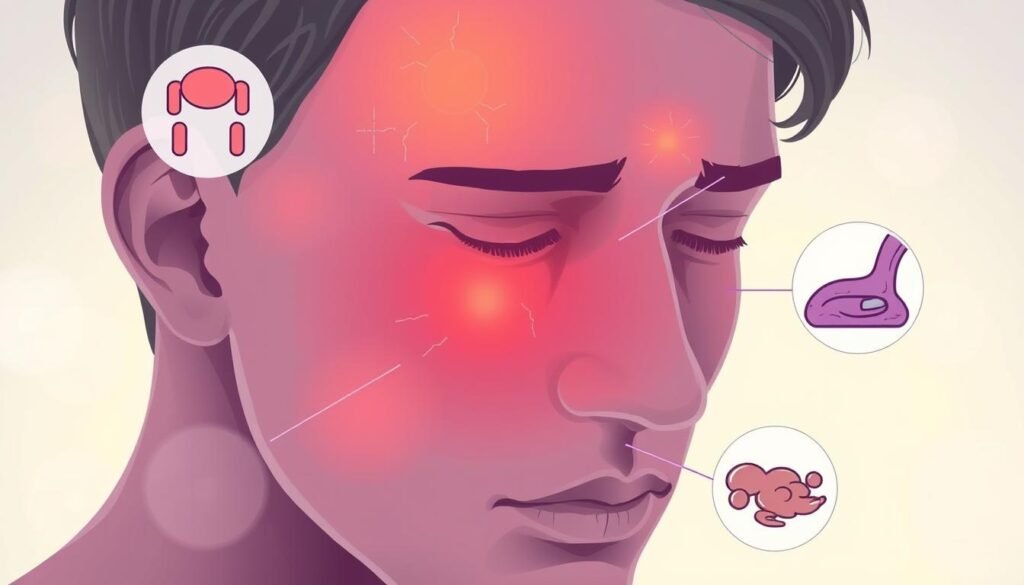
Living with sinusitis can be tough. I often think about what causes sinus pressure and how to ease symptoms. Sinusitis affects millions globally, making it key to find effective treatments. Decongestants and antihistamines can help by reducing nasal inflammation and allergy-related pressure.
I aim to guide you through the world of sinus relief. We’ll explore symptoms, causes, and treatment options. This will help you manage sinusitis and find relief from sinus infections and pressure.
Understanding sinusitis is vital. Most symptoms come from viruses, and bacterial infections can last long, causing high fevers. We’ll look into the importance of effective treatments and how to manage sinusitis. We’ll discuss using nasal corticosteroids, decongestants, and immunotherapy.
Key Takeaways
- Sinusitis affects millions of people worldwide, and it is essential to find the right treatment for symptom relief.
- Decongestants and antihistamines can help reduce inflammation and relieve sinus pressure.
- Over 80% of sinus infection symptoms are caused by viruses.
- Bacterial sinus infections can last for 10 days or more, not improving with time, causing fevers of 102 degrees or higher.
- Nasal corticosteroids, decongestants, and immunotherapy can help manage sinusitis.
- Staying hydrated and using steam inhalation can help ease congestion and sinus pressure.
Understanding Your Sinus System
To tackle sinus congestion, it’s key to grasp the sinus system’s basics. The system includes four sinuses: frontal, maxillary, sphenoid, and ethmoid. These sinuses link up and connect to the nasal cavity, creating air-filled spaces within the skull.
The paranasal sinuses, like the maxillary and frontal, are covered in a mucous membrane. This membrane filters the air we inhale, removing dust and germs. But, when it’s not working right, it can cause sinus issues like headaches and congestion.
Many things can upset the sinuses, like infections, allergies, and colds. These can make the sinuses swell and get clogged, leading to symptoms like a stuffy nose and headaches. Sometimes, surgery is needed to fix these problems.
Getting to know the sinus system is vital for treating sinus issues. By understanding how it works and what can go wrong, we can take steps to prevent and treat congestion. This improves our overall health and well-being.
Recognizing Different Types of Sinus Problems
Sinus problems can be acute or chronic. It’s key to know the difference to get the right treatment. Chronic sinusitis affects millions, causing long-lasting nasal congestion and blocked sinuses. Its symptoms can be hard to tell apart from a cold or allergies.
Some common sinus issues include:
- Acute sinusitis, which lasts less than four weeks
- Chronic sinusitis, which lasts at least 12 weeks
- Recurrent acute sinusitis, which occurs four or more times in a year
Knowing the type of sinus infection is vital for proper diagnosis and treatment. This includes managing allergies and using tests like high definition nasal endoscopy and miniCT sinus scans. Sometimes, surgery is needed to clear blocked sinuses and ease nasal congestion.

Sinus problems can really disrupt your day, causing pain and discomfort. Recognizing the different types is the first step to finding relief from symptoms like nasal congestion and blocked sinuses.
My Experience with Chronic Sinusitis and What I’ve Learned
Living with chronic sinusitis is tough, as it causes ongoing sinus pressure and pain. I’ve found that to manage it, you need a full plan. This includes getting medical help when needed and knowing the signs of a sinus infection. It’s key to know the difference between acute and chronic sinusitis. Chronic sinusitis lasts more than 12 weeks or keeps coming back.
Some people find relief with over-the-counter meds or antibiotics. But others need more sinus treatment options. Working with a doctor is vital to find the right treatment. They can spot the root cause, like anatomical problems or allergies, and create a plan just for you.
Don’t ignore warning signs like severe headaches, facial pain, or colored nasal discharge. If you see these, get medical help fast to avoid worse problems. By being proactive and caring for your sinuses, you can lower the chance of chronic sinusitis and get sinus relief.
Immediate Relief Strategies for Sinus Pressure
There are many ways to quickly ease sinus pressure. Steam inhalation and nasal irrigation are top choices for sinus congestion treatment. These methods help clear out mucus, easing sinus discomfort.
Drinking lots of water is also key for sinus pressure relief. It makes mucus thinner, making it easier to get rid of. You can also try over-the-counter decongestants and pain relievers. But, always follow the dosage to avoid side effects.
Other home remedies for sinus relief include warm face compresses and using a humidifier. Avoiding hard nose-blowing and too much alcohol or caffeine is also important. Adding these steps to your daily routine can help you feel better.
Here are some more tips for easing sinus pressure:
- Use saline rinses to clear out mucus and debris
- Keep your head elevated to reduce congestion
- Try over-the-counter pain relievers such as NSAIDs for sinus pressure relief
- Avoid allergens and irritants that can trigger sinus pressure

If your symptoms don’t get better or get worse, see a doctor. They can find out why you have sinus pressure and suggest the best treatment.
Natural Remedies That Actually Work for Sinus Relief
Looking for natural ways to ease sinus problems? There are many options that can help. Steam therapy and nasal irrigation are great for clearing out nasal congestion and reducing swelling. They’re perfect for those dealing with sinus pressure from allergies or colds.
Essential oils and aromatherapy are also effective. Oils like eucalyptus and peppermint can help ease sinus pressure and congestion. Eating right and staying hydrated can also help thin out mucus and clear your sinuses.
Steam Therapy and Nasal Irrigation
Steam therapy and nasal irrigation are simple and effective. Using a saline rinse or neti pot can clear out congestion and reduce swelling. They’re great for those with chronic sinus problems looking for natural relief.

Dietary Changes for Sinus Health
Diet also plays a big role in sinus health. Drinking plenty of water and eating a balanced diet can help thin mucus and clear sinuses. This is very helpful for those with chronic sinus issues.
Some foods that can help include:
- Chicken soup
- Garlic
- Onions
- Citrus fruits
By adding these foods to your diet and using natural remedies like steam therapy and essential oils, you can find natural sinus relief.
| Remedy | Benefits |
|---|---|
| Steam Therapy | Clears out nasal congestion, reduces inflammation |
| Essential Oils | Provides natural decongestant properties, relieves sinus pressure |
| Dietary Changes | Helps to thin mucus, clear sinuses, provides natural sinus relief |
Medical Treatments and Their Effectiveness
If you have severe sinusitis symptoms like facial pain or trouble breathing, you need to see a doctor. There are many medical treatments for sinusitis, like antibiotics and surgery. Studies show that chronic rhinosinusitis (CRS) affects up to 12% of Americans, 10% of Europeans, and 8% of Chinese.
Some effective sinus infection remedies include nasal corticosteroids like fluticasone and budesonide. They help prevent and treat swelling. Saline nasal rinses are also good for clearing sinuses. You can use special squeeze bottles or neti pots at home. For severe cases, doctors might give corticosteroid shots or pills, often for nasal polyps.
The table below lists some common treatments for sinusitis:
| Treatment | Description |
|---|---|
| Nasal Corticosteroids | Prevent and treat swelling |
| Saline Nasal Rinses | Clear sinuses |
| Corticosteroid Shots or Pills | Treat severe sinusitis |
It’s important to talk to a healthcare professional to find the right treatment for your sinusitis. They can suggest the best sinus infection remedies and medical treatments.

Preventing Sinus Infections: My Pro Tips
To stop sinus infections, knowing what causes them is key. Sinus pain can be managed with medicine and home remedies. But, it’s more important to prevent infections to avoid them coming back.
Using a humidifier in your room can add moisture to the air. This helps prevent dryness that makes sinus problems worse.
Changing your lifestyle can also help. Drinking lots of water can thin out mucus and help it clear out. Also, sleeping with your head raised can help avoid sinus symptoms and reduce congestion.
By making these easy changes, you can lower your chance of getting sinus infections. This can also help ease sinus pain.
Other ways to prevent sinus infections include using nasal sprays to reduce swelling. Steam therapy can also help moisten your nasal and sinus passages. It’s also important to stay away from air pollutants like cigarette smoke and cleaning products. These can make sinus problems worse.
By following these tips and making a few simple changes, you can prevent sinus infections. This can help reduce your risk of sinus pain and pressure.
Preventing sinus infections needs a mix of environmental changes, lifestyle adjustments, and self-care. By avoiding sinus problems, you can lower your risk of infections. This lets you breathe better and live a healthier life.
When to Consider Sinus Surgery
Sinus surgery is considered when other treatments don’t work for blocked sinuses. The goal is to ease symptoms and cut down on infections. There are different surgeries, like endoscopic sinus surgery and balloon sinuplasty.
Some important things to think about when considering sinus surgery include:
- Endoscopic sinus surgery uses thin instruments with a camera to clear blockages
- Balloon sinuplasty uses a balloon to open up blocked areas for better drainage
- Surgery may not cure sinusitis but helps manage symptoms and infections
Talking to a doctor about the risks and benefits of surgery is key. Surgery should be a last resort. Modern nasal surgery is less painful and has a quick recovery.
Most people see improvement after surgery, but might need more treatment. It’s important to follow postoperative care, like managing nasal stuffiness and taking pain meds.
| Procedure | Description |
|---|---|
| Endoscopic Sinus Surgery | A common procedure that involves inserting thin instruments with a camera to remove blockages |
| Balloon Sinuplasty | A newer type of surgery where a balloon is inflated in the blocked area to improve sinus drainage |
Conclusion: Taking Control of Your Sinus Health
Managing sinus health is a big job. It involves understanding your sinus system, knowing the different sinus problems, and getting the right medical help. This way, you can take charge of your sinus health and get lasting relief.
Bacterial sinusitis is rare, happening in only 0.5 to 2 percent of cases. Often, sinus symptoms can go away without antibiotics. Up to 75 percent of people with bacterial sinusitis get better in a month without treatment. But, if your symptoms don’t get better or get worse, see a doctor. They can figure out what to do next.
Using natural remedies and making lifestyle changes can also help. Try steam therapy, nasal irrigation, changing your diet, and using essential oils. These methods can help you find relief and stop sinus infections from coming back. By managing your sinus health, you can get quick relief and improve your overall health in the long run.